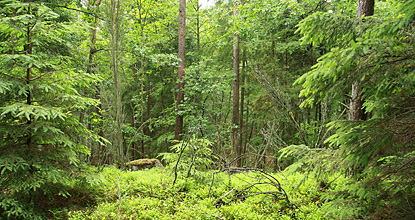Theme 3: Continuous cover forestry
TC4F’s research on continuous cover forestry is carried out in two main areas: management of heterogeneous forests and conversion of single-layer to multi-layer forest.

The multi-layered forest in Eriksköp, Tönnersjöheden experimental forest in Halland, is an important study object. Photo Mats Hannerz.
Continuous cover forestry (often referred to as forestry without clearcuts) is attracting considerable interest despite the lack of practical experience. The method is based on selective cuttings, and the stand is never clear cut. A long-term, financially sustainable continuous cover forest requires a heterogeneous forest with trees of all size classes. Regeneration depends on natural seeding or on supplementary planting and direct seeding.
Management of multi-layered forests
One field trial in the county Halland is used to evaluate how different management regimes affect the long-term growth, economy and regeneration in an extremely heterogeneous forest. The stand is an over 100 year old forest established after direct seeding. The stand is today a mixture of oak, pine and spruce in all size and age classes. The stand is used to compare different harvesting and regeneration principles.
Conversion from single-layer to multi-layer forest
TC4F has enabled the establishment of new trials that will be used to evaluate the potential to convert single-layered to multi-layered forests. The premise is a relatively homogenous and young spruce forest that is strongly thinned. Some parts of the stands will be cut to maximise the distribution on tree sizes, while other parts will be cut to achieve a more even distribution. The trials, located in the counties Jämtland and Småland, will provide interesting contributions to the discussion on how volume production is affected by whether the stand is homogeneous or heterogeneous.
Links
Contact
Lars Drössler, Southern Swedish Forest Research Centre, SLU, lars.drossler@slu.se